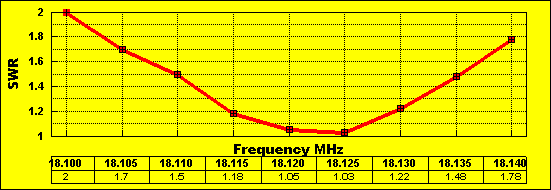Using a Small Transmitting Loop
Having constructed, and positioned the magnetic loop antenna- and
run the co-axial feeder to the transmitter and control line into
the up/down control box for remotely tuning the loop, what then?
First step is to tune the loop coarsely on receive. The loop acts
as a very narrow band pass filter, and although loops are
relatively insensitive to electrical noise, when connected to a
receiver, the noise floor significantly comes up when the loop
passes through resonance.
Look at the plot below of SWR against frequency. The noise from
the receiver varies inversely with SWR shown here and you can see
that there is relatively little change in frequency for change in
match. The 80m loop is narrower still - and it is quite possible
to build a loop that is too narrow for ssb transmission!

An SWR bridge is the main tool used when tuning
an STL. A cross needle or other direct reading SWR display
is especially handy.
The received noise level peaks significantly when on tune, and
the SWR dips very sharply when fine tuning with a half a watt or
so on transmit.
Having tuned the loop broadly on receive, switch to transmit and
using a watt or so of energy, fine tune the loop on transmit for
lowest SWR. The lowest SWR I can manage is unmeasurable on a good
day, but when the leaves are thick, or its very damp, then 2:1
can be good. This is probably a sign that the housing of the
antenna is leaky - or that the tress that grow through the 80m
loop need pruning again!
Turning the band is not as simple as with wire
antennas - but with practice it isnt difficult to track the
antenna with the receiver. Of course some of us have valve P.A.s
that take just a mite of adjustment before hitting the TX button.
Email GW0TQM

Carl GW0TQM's Magnetic loop page
Contributions comments and STL links welcomed.
Magloop home What?
Using Building BASIC Software Links
More reading and reports
Sign
the Magloop Guestbook  View
the magloop Guestbook
View
the magloop Guestbook

